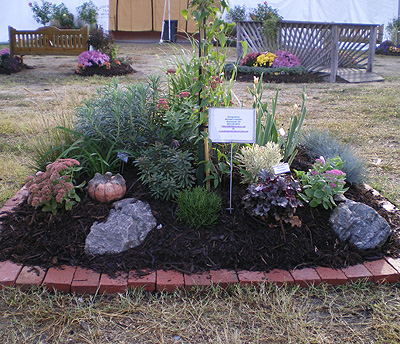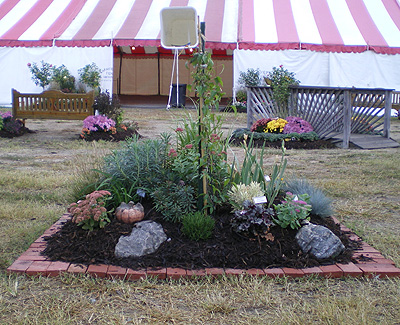The late Dr. Lloyd Zurbrigg worked for decades to popularize reblooming or remontant bearded irises. The trait was originally traced to median breeding development. The big problem was obtaining both modern flower form and reliability in the class. The use of West Coast originations by Clarence Mahan, Earl Hall, Jane McKnew, Dr. Zurbrigg and others led to a number of reliable Eastern tall bearded rebloom introductions with improved flower form in the early nineties. The public and AIS judges would soon take notice.
‘Clarence’ (TB 91) was the best of Doc Zurbrigg’s early nineties releases. Flowers featured white standards tinted violet. Falls were light blue violet with a white center and hafts. A sweet fragrance completed the package. Named for Clarence Mahan, a former AIS president, it was the first tall bearded reliable rebloomer to be a finalist for the Dykes Medal. The eastern remontant’s unknown parentage has been the subject of countless speculation over the years. One of its offspring, ‘Daughter of Stars’ (D. Spoon, 00) is currently a finalist for the Dykes Medal on the 2010 AIS National Ballot.
‘Matrix’ (TB, Hall, 91), ‘Rosalie Figge’ (TB, McKnew, 93) and ‘Renown’ (TB, Zurbrigg, 92) have West Coast lineage in them. Schreiner breeding for black, for instance, involved the use of Iris aphylla. Its presence in Dykes Medalist ‘Titan’s Glory’ (TB, Schreiner, 81) coupled with ‘Violet Miracle’ (TB, Zurbrigg, 79)
created the McKnew tall bearded rebloomer with impeccable flower form and coloring. ‘Rosalie Figge’ is still the best reliable purple remontant on the market to date. The possible influence of I. aphylla in the parentage is also finally leading to work to trace its impact on rebloom.
Rebloom breeders for the most part took their cue from Zurbrigg releases. The late Monty Byers used a number of Doc’s introductions for his groundbreaking rebloom program. Working out of California, Byers also weaved the late Ben Hager’s rebloom influences into his breeding lines. Many of his early nineties originations are still widely grown and used in current breeding.
Sterling Innerst, another Eastern breeder from Gettysburg, PA used both Zurbrigg and Hager remontants to create selections with good form and dynamite reliability. ‘Again and Again’ (99), a medium yellow and ‘Over and Over’ (00), a light lavender plicata are a pair of tall beardeds turning in summer and early fall rebloom in my garden. These Innerst introductions have big, blocky flower forms making them attractive for future breeding ideas. Their potential stud worth is still largely untapped.
Betty Wilkerson, a long time Kentucky rebloom advocate, has begun releasing a number of important tall bearded remontants. Her best effort so far seems to be ‘Echo Location’ (07). Pale yellow flowers have reddish brown haft lines around bright yellow beards. A product of ‘Innocent Star’ and ‘Rebound’, this overlooked Eastern TB faithfully initiates its heavy fall bloom sequence in mid to late September for me.
‘Just Call Me (Wilkerson, 08), another tall bearded rebloomer with ‘Clarence’ heritage, has turned in outstanding early fall bloom in consecutive years. Standards are white and falls have a pale blue wash with lots of ruffles. ‘Love Lines’ (Wilkerson, 06) is the pod parent for this enchanting remontant. Each parent gave its offspring their best traits. ‘Just Call Me’ may indeed have a charmed future for breeders and growers alike.
‘Stargate’ (02), ‘Radiant Bliss’ (06) and ‘Tara’s Choice’ (03) are other recent Wilkerson TB introductions with October flowers in my Central Virginia garden. ‘Radiant Bliss’ may have the best chance to succeed in colder climates. The Kentucky origination features greyed orange standards. Falls have white ground with beetroot and gold plicata overlay. Three-year clumps had a wealth of stalks and flowers beginning in late September in Zone 6. Further, garden testing will determine whether its 2009 performance was a fluke or a trend.
 |
| Mike Lockatell with Debbie Hughes during his 2010 visit |
Two recent Zurbrigg tall bearded, rebloomers may play to a larger gardening audience. Both releases have received little fanfare but they continue to provide consistent reliable early fall flower in Zone 6. ‘Gate of Heaven’ (04) was nearly lost in its introduction year. Thankfully, Doc sent it to my Powhatan, VA garden for testing and further breeding. Another child of ‘Clarence’, its medium blue coloring can be blue violet during its fall bloom sequence. A garden iris, my breeding mentor’s final introduction has been an outstanding early September performer for me. A convention guest, it rebloomed in Jim Murrain’s suburban Kansas City garden last year.
Zurbrigg’s ‘Twilight Fancies’ (01) is another tall bearded remontant receiving little notice for its reliable rebloom prowess in my area. One of its parents is ‘Iceland’ (Byers, 91). The white and pale blue tall bearded rebloomer from California turned in outstanding early fall results in Region 4 gardens in 2009. ‘Twilight Fancies’ has received ‘Iceland’s’ best traits. A blue neglecta, rebloom performance mirrors its parent in my garden.
Due to a lack of serious promotion and scant breeding development, rebloom’s worth has not been realized in colder climates of the Continental US. Late spring and summer night temperatures below 60o F drive fall flower. If plants have received adequate fertilization and watering, good fall bloom dramatically improves. Rebloom is still not an exact science. Recent study is contributing new clues to the behavior of the rebloom sequence.
My visit to Kansas City and St. Joseph in late March was an opportunity for an Eastern breeder to plead rebloom’s case in our nation’s heartland. Thank you to Greater Kansas City Iris Society and Pony Express Iris Society for your wonderful hospitality and fellowship during my March visit. Rebloom has its place in iris culture.
Add your vote to mine as we advocate its value to a larger gardening audience.
From the AIS Region 18 Fall 2010 Bulletin




